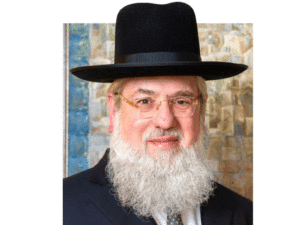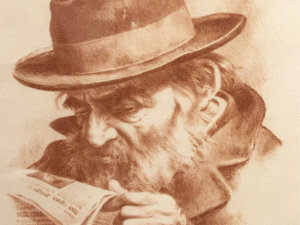I often joke with some of my contemporaries about being the product of intermarriage. My father was Polish, my mother Hungarian. Before the churban of the Holocaust, this union would probably never have happened. However, after Hitler ym”sh, these artificial barriers disappeared and hybrids like me were born. Thus, I connected with my father’s world when my shul and I traveled to Poland last year and with my mother when we journeyed to Hungary this year.
It took a while, but I began to understand the difference. The common language for my parents was Yiddish, and so my first words upon reaching America as a two-year-old were “groisse vasser.” But growing up, I never understood why my mother and her friends still spoke Hungarian, while my father spoke only Yiddish, never Polish, to his fellow survivors. Listening to my colleague on the trip, historian and podcaster Yehudah Geberer, I began to understand. Approximately 568,000 Hungarian Jews were murdered during the war, while some ninety percent of Polish Jewry, about three million souls, were murdered by the Nazis. Perhaps more importantly, “most of the Jews of Hungary lived in relative safety for much of the war” (Encyclopedia of the Holocaust, page 273). In fact, as late as 1944, from July until October, the Jews still lived in relative safety.
But then the reign of terror perpetrated by the newly formed fascist government of Ferenc Szalasi and his virulently anti-Semitic Arrow Cross Party began. Nearly 80,000 Jews were slaughtered in Budapest alone, where many were shot on the banks of the Danube, the river running through much of Europe. The members of my shul and others who had joined us stopped at the banks of the river to contemplate the “Shoe Memorial,” where many Jews were shot. The shoes – those of men, women and tiny children – are a silent indictment of the perfidy of Hungarian “friends and neighbors” who perpetrated their own brand of Holocaust upon our brethren.
I learned from Yehudah that when the Hungarian murders took place, the war and Holocaust were ostensibly over. The concentration camps had already been liberated and disbanded. The Nazis had fled and some were killed or arrested. But the local Hungarians turned on their former friends, murdering them in cold blood, which turned the Danube into a river of makkas dam of Jewish blood.
Now I understood. While the Polish Jews had a thousand year history of anti-Semitism, culminating at one point in the Tach V’Tat massacres of 1648-49, the Hungarian Jews proudly spoke the native language and felt comfortable in their surroundings. Even after the war, and as is still evident today, Hungarian is spoken because it is in the bones, heart and minds of my mother’s friends and family. This is said with a newfound understanding, not G-d forbid condemnation or criticism. It is simply an inner realization after half a century of contemplation. We visited something called the “Glass House,” which was in effect an ihr miklat – kind of safe house – for Jews being hunted down to be killed. Yet, our guide, an elderly Hungarian Jew, broke down emotionally when he recalled that the people with whom he played when growing up and who shared the common ground and air turned on them viciously. These were not German-barking Nazis who herded them into freight trains to Auschwitz, but once-trusted gentiles who were rewarded with precious cholent and kugel for acting as Shabbos goyim.
I arrived back in Cedarhurst, boruch Hashem, just in time for Shabbos, simchos and a double aufruf. But I was still haunted by the heaving shoulders of the man in the glass house, because his friends had betrayed him. Back at the shoes, spontaneously, with no prior plan, I asked my fellow travelers to recite Tehillim with me, after which I said Kaddish for the lost souls of the Danube. We finished with the niggun Klal Yisroel has been singing since Shemini Atzeres, Acheinu kol Bais Yisroel. As we moved away from the Shoe Memorial, we spotted a group of secular Israelis who had apparently been answering to the Kaddish and sang along. I didn’t notice, but someone later told me that some of them had put shmattes on their heads out of respect. Apparently, one of them couldn’t find anything, so he put a flip-flop on his bare head. If so, his tribute to the kedoshim may have been the most meaningful one of all.
To explain, I hope that I will be forgiven for quoting a bit from my book Days of Reflection, Days of Joy, which began as an article in this newspaper:
“Some of the most poignant memorials to Churban Europa are the seemingly endless piles of shoes… But one must wonder: Why is the shoe such a powerful symbol of lost humanity? …The Sefas Emes (Pesach 5637, page 56) quotes the posuk, “But your footsteps were so lovely when shod in pilgrim’s sandals, O daughter of nobles” (Shir Hashirim 7:2). The Gemara (Sukkah 49b) interprets this as referring to the beauty of the members of Klal Yisroel when they went up to visit the Bais Hamikdosh on Yom Tov. The Gerrer Rebbe eloquently points out that, far from a burden, these journeys were a gift from Hashem, for they unified the Jewish people…
“The Sefas Emes also notes that Chazal apply these words to the closing moments of the Yomim Tovim, known as ne’ilas hachag, words that are related to the term for shoes, naalayim. What is this cryptic connection? He answers that just as the shoe guards the foot, so does Hashem [through the Yomim Tovim] protect us spiritually…just as shoes protect us from mud and other earthly elements. Finally, the Sefas Emes enigmatically refers us to the Rambam (Hilchos Ishus 13:1) that a person should purchase new shoes for the members of his family for Yom Tov.”
The article goes on to quote from Rav Ovadiah Yosef that one should not walk barefoot because “the primordial serpent was given the dust of the earth as his food, which therefore reeks of his noxiousness.” In fact, Rav Chaim Palagi quotes his father as teaching that naal (shoe) is an acronym for nochosh afar lachmo (the snake, dust is his bread).” On the other hand, at holy places, such as when Moshe Rabbeinu stopped at the Burning Bush and when Kohanim duchen, there is no need for shoes, for the ground itself is holy.
“The Malbim (Rus 3:4) goes even further. He writes that “the very essence of our human bifurcated condition is that the body is essentially the shoe of the soul… The soul could not exist in the spiritually dangerous wasteland that is the earth below without the protection of the body… The mekubalim teach that this is also the esoteric meaning behind the removal of one’s shoe in the rite of chalitzah. By refusing to marry his brother’s childless widow (yibum), this man displays unwillingness to grant the deceased a second pair of shoes – that is the child who would embody his soul and enable him to walk safely through this world – so he must symbolically have his own shoe removed.”
I shared some of this with my fellow travelers to indicate the depth of meaning in these Shoe Memorials. Of course, those who developed these shrines had none of this in mind. But the reason they resonate so deeply with everyone is the universal feelings evoked by shoes in the mind and heart of every Jew. Since the Danube was one of the last stops on our journey to Hungary, we were also able to contrast the silent cry of the shoes with the joy of visiting the kever of Rav Shayele of Kerestir.
We went to Kerestir a few days after the yahrtzeit because it has become such a popular day to visit that it is actually almost impossible to get the full complement of his overwhelming warmth, hospitality and devotion to feeding everyone. In fact, some of Rav Shayele’s grandchildren, led by Reb Mendel Rubin, are rebuilding his shul and expanding the ability to share his incredible legacy of chesed. These days, people arrive by helicopter from Budapest and all over just to bask in the aura of Rav Shayale’s goodness. During his heyday, between 700 and 800 people visited the rebbe and were fed daily. After pondering the horrors of the Nazis and anti-Semites of Budapest, it is reassuring to know that Hashem sends us giants such as Rav Shayele to restore our faith. The many stories about miracles happening regularly at Rav Shayele’s table are inspiring enough. However, it is Rav Shayele’s middos, colossal heart, limitless love, and boundless belief in people that we should take away from Kerestir.
On the one hand, one of the takeaways from such a trip is that we, as Jews, cannot afford to think that anyone around us is immune to becoming an anti-Semite. We must live with this fear, even paranoia, until our redemption. However, Hashem has also provided us with Rav Shayeles when we needed them. If it was the rebbes of Klausenberg or Bluzhev or Rav Elchonon Wasserman, Hashem sends us towers of strength, belief, trust and inspiration whenever we truly need them. Kerestir is the antidote to the Arrow Cross and their wanton beasts. We, too, have been wounded spiritually by Hamas, since their cohorts voted for them and still defend their savagery.
Our job, difficult though it is, is to focus on the Rav Shayeles, even as we are vigilant against those who would try once again to destroy us. Our ne’ilas hachag for Shavuos this year should be replete with full trust, emunah and love for Hashem. This alone will hopefully get us through these last difficult moments of golus, so that we can return to taking off our shoes because we have come face to face, finally, with kedusha and geulah.







